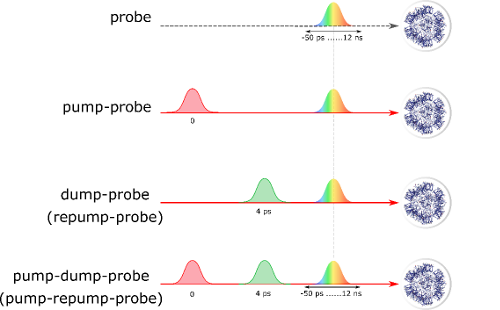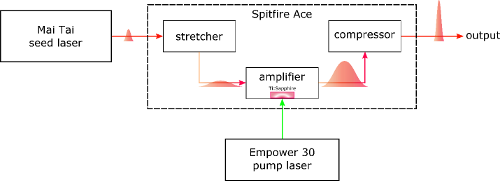The laboratory of optical spectroscopy is equipped with a state-of-the-art femtosecond laser system. We are able to apply a number of experimental arrangements to study light-driven processes in accordance with our projects goals.
Transient absorption spectroscopy has been proved to be a powerful tool for studying the excited state dynamics of different types of molecules. The ultrashort laser pulses ~100 fs allow investigating dynamics of the electronic states in real time. One of the pulses, the pump pulse, excites the molecules to the higher states, the other one, the probe pulse, is sent to the sample with a time delay with respect to the pump pulse. The absorption difference spectra are calculated by subtracting the spectra of the sample in the ground state from the spectra of the sample in the excited state. The difference absorption spectra measured at different delay times after excitation provides the dynamics of various processes.
The capabilities of the well-known femtosecond transient absorption pump-probe setup described above are extended with multi-pulse experiment outline. The multi-pulse setup, frequently referred as pump-dump-probe (pump-repump-probe) setup, allows selectively perturb the population of the molecules by the dump pulse that has been excited upfront by the pump pulse (Figure 1).
Figure 1. A pulse diagram illustrating different pulse sequences for different experiment configurations.
The ultrafast laser system consists of three parts: the seed laser Mai Tai SP (Spectra-Physics), Empower 30 pump laser (Spectra-Physics), and the Spitfire Ace-100F ultrafast Ti: Sapphire regenerative amplifier (Spectra-Physics) (Figure 2).
The output of the laser system consists of pulses with ~100 fs duration, and 4.1 mJ energy per pulse at 1 kHz with a central wavelength at 800 nm. The output is split to several beamlines that later are sent to generate major laser pulses (Figure 3). The pump and dump beams are tuned by a computer controlled optical parametric amplifiers OPAs (TOPAS and TOPAS Prime, Light Conversion) in the 240-2500 nm wavelength range. Each of the beams can be mutually delayed in time, and synchronized in frequency. The probe pulse is sent through the optical delay line that can follow excited state dynamics of the molecules up to 12 ns. The probe light is spectrally broad, generated in non-linear crystals, such as commonly used CaF2 or Sapphire, and can cover the spectral window from 400 to 1300 nm.
If you are interested in studying the ultrafast dynamics of your samples, contact our group for more detailed system specifications. We are always looking forward to new challenges and are eager to discuss new collaborations.








